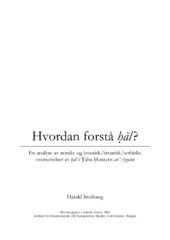Hvordan forstå hal? En analyse av norske og bosnisk/kroatisk/serbiske oversettelser av hal i Taha Husayns al -'Ayyam
Master thesis
Permanent lenke
https://hdl.handle.net/1956/7418Utgivelsesdato
2008-11-19Metadata
Vis full innførselSamlinger
Sammendrag
The translation of the Arabic −hāl, or circumstantial qualifier, can often be a challenge for translators, both into Norwegian and other languages. In Norwegian, the present participle is sometimes perceived as a sufficient substitute, but the truth is that there are numerous situations in which such a simple translation is impossible, and a re-structuring of the sentence in question is necessary. This thesis therefore examines the various possibilities facing a translator in transferring the sometimes complicated meaning of a −hāl into a meaningful and fluent Norwegian sentence. Initially from a theoretical perspective, dealing with the syntactic, semantic and morphological aspects of various structures. Then, to see how the −hāl in fact is translated in literature, a selection of −hāls – mostly −hāl-accusatives, but sometimes −hāl-sentences – in the famous Egyptian writer Taha Husayns novel al-’Ayyām is analysed and compared to their counterparts in the Norwegian translation of the same novel. Special consideration is then given to whether the translated text offers a good image of the original meaning, as well as how well the original form is reflected in the translation, and in cases where there is a certain distance between the two texts, alternative solutions are suggested. The Bosnian/Croatian/Serbian translation of the same novel is analysed similarly. This, however, is done with the assumption that the gerund, or glagolski prilog, in Bosnian/Croatian/Serbian equals the −hāl in most cases, as the two grammatical categories share many characteristics, at least in theory. In situations where this is not the case, it is discussed whether a structure with a gerund could in fact be possible, or if there are specific reasons preventing it. And in either case, as with the Norwegian translation, it is focused on how well the translated text reflects the meaning and structure of the original, Arabic sentence.
